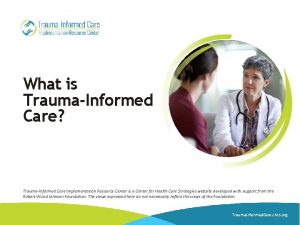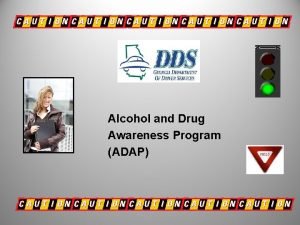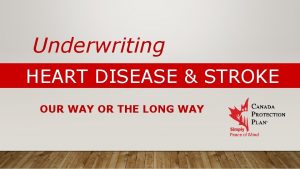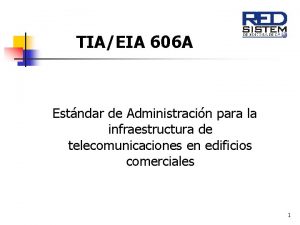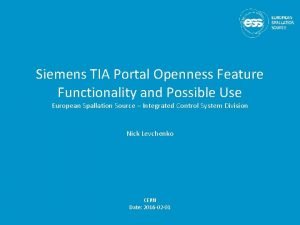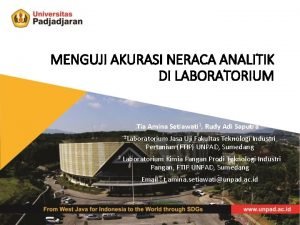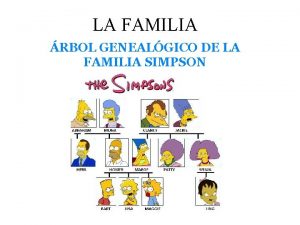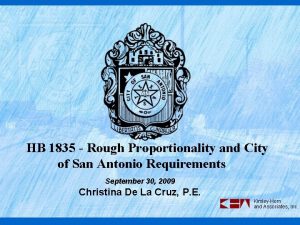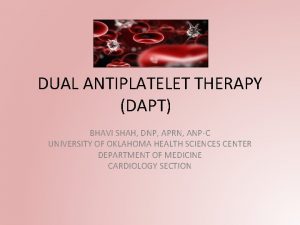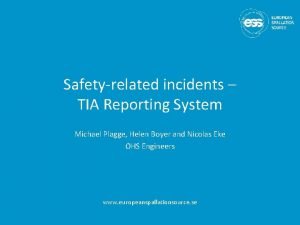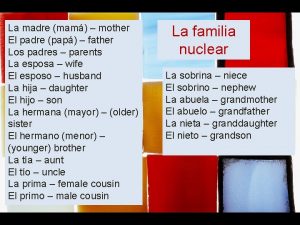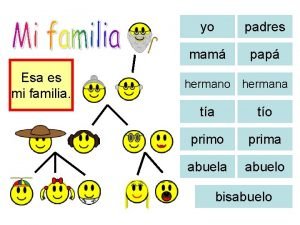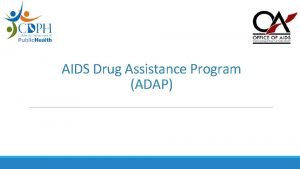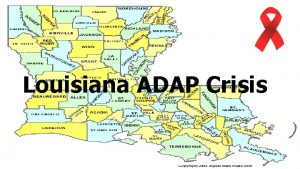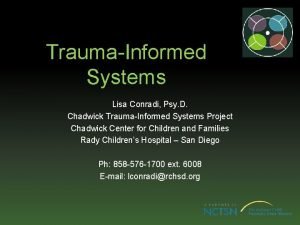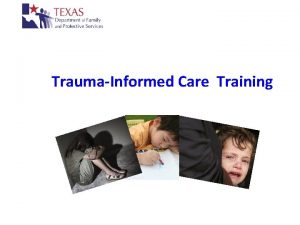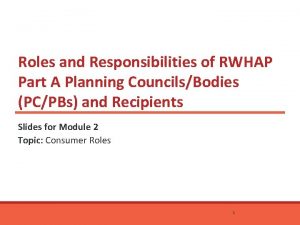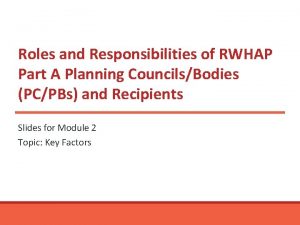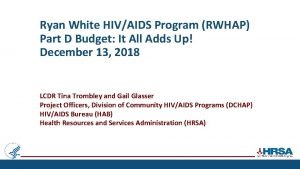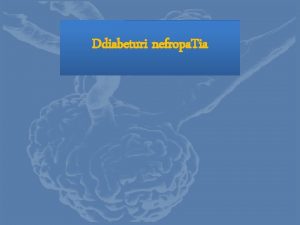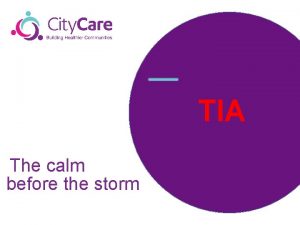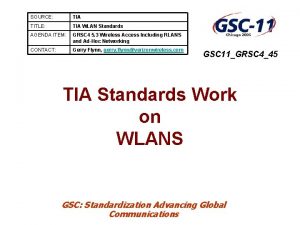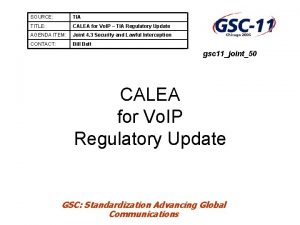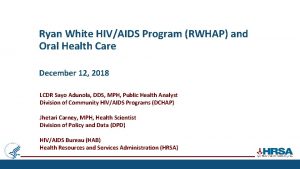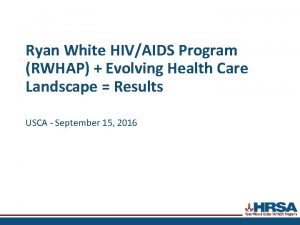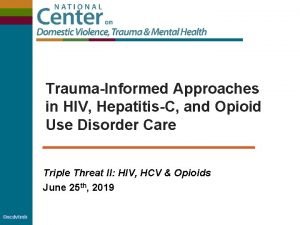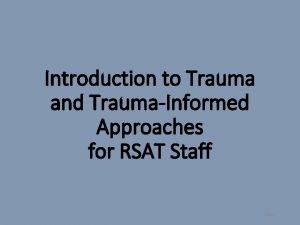TraumaInformed Approaches TIA to RWHAP ADAP and Part











































- Slides: 43

Trauma-Informed Approaches (TIA) to RWHAP ADAP and Part B Program Mahelet Kebede, MPH Holly Hanson, M A Manager, Health Care Access NASTAD Ryan White Part B Program Manager Iowa Department of Public Health December 12, 2018

PRESENTATION OVERVIEW • • Introduction Understanding Trauma-Informed Approaches (TIA) Toolkit Population-Specific Focus: Engaging Black Men in Care State Example: Iowa Department of Public Health Discussion/Q&A Activity 2

UNDERSTANDING TRAUMA

WHAT IS TRAUMA? TRAUMA is broadly defined as experiences that produce intense emotional pain, fear, or distress, often resulting in long-term physiological and psychological consequences. Experiences of trauma, especially in childhood, can change a person’s brain structure, contributing to long-term physical and behavioral health problems. TRAUMA-INFORMED: Being trauma-informed is an approach to administering services in care and prevention that acknowledges that traumas may have occurred or may be active in clients’ lives, and that those traumas can manifest physically, mentally, and/or behaviorally. TIC vs TIA: trauma-informed care is one type of trauma-informed approach. There is SO much more you can do outside of the direct care you and/or your sub-recipients provide.

NEAR SCIENCE - NEUROBIOLOGY


NEAR SCIENCE - ACEs

NEAR SCIENCE – ACEs: IOWA DATA 8

Iowa ACE’s Data by ACE Category

NEAR SCIENCE - EPIGENETICS

NEAR SCIENCE – RESILIENCY There is no single accepted set of components of resilience, but this set of characteristics and contributing factors can provide a useful guide: • OPTIMISIM • HAVING A ROLE MODEL • ALTRUISM • SOCIAL SUPPORTS • MORAL COMPASS • FACING FEAR • FAITH & SPIRITUALITY • PURPOSE IN LIFE • HUMOR • TRAINING 11

INTERSECTIONALITY Intersectionality is a theory that the overlap of various social identities, such as race, gender, sexual identity, disability, and class, contribute to systemic oppression and discrimination experienced by an individual. GENDER IDENTITY SEXUAL ORIENTATION RACE ADDICTION & MENTAL HEALTH POVERTY & HOMELESSNESS

HIV ACEs PYRAMID

TRAUMA THROUGHOUT HIV CONTINUUM

VICARIOUS TRAUMA Vicarious trauma can occur in providers as a result of bearing witness to the experience of trauma in others. Providers are exposed to trauma through hearing about traumatic experiences or being witness to symptoms of trauma in their clients (e. g. , aggression or anger). Vicarious trauma can lead to various levels of burnout and compassion fatigue, impacting high rates of turnover in many organizations that serve PLWH. Furthermore, many persons in helping professions are drawn to the work based on their own personal experiences, thus increasing risk for vicarious trauma.

Dr. Edward Machtinger, UCSF 16

TRAUMA-INFORMED APPROACHES TOOLKIT


TIA MODULES









BLACK MEN LIVING WITH HIV 28

Black Men Living with HIV Source: CDC HIV Surveillance Report: Diagnoses of HIV Infection in the United States and Dependent Areas , 2015; vol. 27. Race/Ethnicity groups representing less than 1% of HIV Diagnosis were note included (Native Hawaiian/Other Pacific Islander and American Indian/Alaska Native) 29

Black Men Living with HIV New HIV Diagnoses in the United States for the Most-Affected Subpopulations, 2015 Source: CDC. Diagnoses of HIV infection in the United States and dependent areas, 2015. HIV Surveillance Report 2016; 27. Subpopulations representing 2% or less of HIV diagnoses are not reflected in this chart. Abbreviation: MSM, men who have sex with men. 30

Treatment Needs of Black Men Living with HIV ▪ Significant toxicities such as high cholesterol, diabetes, and excess cardiovascular comorbidity, present challenges for providers managing HIV care. o Black men experience these comorbid conditions at disproportionately higher rates. • These disproportionate outcomes are largely due to social determinants of health (i. e. , social and economic factors, physical environments, and health behaviors). 31

RWHAP Policy and Program Considerations ▪ ADAPs’ Support of Treatment Access via Formularies o RWHAP Section 2616(c)(6) of the Public Health Service Act ▪ RWHAP Part B Minority AIDS Initiative (MAI) Targeted activities o Targeted audiences o Traceable clients o ▪ Access, Adherence, and Monitoring Services (ADAP Flex) o Funds improve access to medications, increase adherence to medication regimens, and help clients monitor progress. 32

Drug and Service-Specific Information ADAP RWHAP Part B • Cardiac medications • Medical Case Management • HCV treatment medications • Mental Health Services • Mental health treatment medications • Outreach Services • Metabolic agents • Non-Medical Case Management • Psychosocial Support Services 33

STATE EXAMPLE: IOWA DEPARTMENT OF PUBLIC HEALTH

HISTORY LESSON-HOLLY’S PERSPECTIVE

Iowa’s Journey to Integrating Trauma Informed Principles into Part B Services ● First Trauma Informed Excellence Training for all Part B Case Managers Holly begins at IDPH as RW Part B Manager. 2001 1999 Shooting at Columbine High School on 4/20/1999. Holly works at Columbine Connections until May 2001. ● ● TIC included in the Integrated Comprehensive Plan. Iowa received Part B Supplemental money. Hired Trauma Informed Coordinator. 2016 2011 2008 Began MCM Certification for all Iowa Part B Case Managers with organization out of Colorado. Met Matt Bennett. 2017 -18 2015 ● ● Included ACE’s Questions in the HIV Consumer Needs Assessment. Started IDPH TIC Workgroup ● ● ● Hired consultant for development of trauma informed strategic plan TIE expanded to include Bureau and testing sites Statewide, multi-sector group formed

Trauma Training for Part B Subrecipients 1) Core component of Medical Case Management Certification from Coldspring Center- Blended Learning of online curriculum + 2 -day in-person training 1) Trauma-informed excellence, or TIE, model is a required extensive online training required of all RW subrecipients. One cohort per year is offered.

Formation of IDPH Workgroup ▪ ▪ ▪ ▪ ▪ HIV Early Childhood Mental Health Tobacco Control Domestic/Sexual Violence Substance Use (Prevention and Treatment) Health Equity Nutrition and Physical Activity Chronic Disease Prevention and Management Emergency Management Services Planning Services Vision - Healthy Iowans in trauma-sensitive communities Mission - Create a trauma-sensitve culture that promotes action based on the evidence connecting trauma, health, and well-being.

1 ice lis s hed 3 nd ga in in tra rin g hi fo rm in n 4 5 d an H um s to avin to tra g a atra um sy re in a ste ed se m sp pr nsi of on of tiv o es e nsi sio tre sit ve e na at t ls me rea nt tm s, e w nt ar , r m ef -h er an ra do ls ff er u vic eve r cl es nts ien do an ts n’ d/ hav De t r or e et c l ra hr se iv um on e rv at ic r ize ic tr a e Ch eca at ro ut e ‘U As ni io ex sum ns niv c st pe in St ’ e th res rien g m fo rsa r em s e c e o ss r A l. nsu ed t st o re rau r a CE s o m ll o ’s ur at f s ic o g ca an e he ue re a d lp n of in d to f t g p bu he ro rn clo fe ou ck ssio t is is ns a r cr. P ea iti ro l ca m In l. ot t in Pr eg g r Pr pr om ev ot en e Co t b sta pr mp o ur ff se b as lf- lem sio no se ca re in n fa ut lfo th ti ug h ro th a- Cr w ea or te kp a Ac la tra pr co ce u m ac m t p 2 ed re se at ss e m st en ra t te to gie ol s. to Pr Or ior ga itiz ni e U za Ch de tiliz tio an te e a rm n na gi in d o e rg l C ng ba an se iz ul lin at tu e ion an a re d la c s Next Steps for Part B Subrecipients- Develop strategies to ensure these areas of focus are met and sustained.

Q&A DISCUSSION 40

TRAUMA-INFORMED ACTIVITY

PATIENTS AT UCSF 42

CONTACT INFORMATION Mahelet Kebede, MPH Manager, Health Care Access 202. 434. 8098 | mkebede@NASTAD. org Connect with us: Linked. In | Facebook | Twitter | You. Tube NASTAD | 444 North Capitol Street NW, Suite 339 | Washington, DC 20001| NASTAD. org 43
 Traumainformed care
Traumainformed care Tadra is an acronym for the state of georgia
Tadra is an acronym for the state of georgia Hikmah beradab dengan jiran
Hikmah beradab dengan jiran Cva vs tia
Cva vs tia Tia/eia 606a
Tia/eia 606a Tia na dosah
Tia na dosah Ansi/tia/eia-606-a
Ansi/tia/eia-606-a Tia portal exporter file
Tia portal exporter file Tia madura
Tia madura ông mặt trời rực rỡ chiếu ngàn tia nắng vàng
ông mặt trời rực rỡ chiếu ngàn tia nắng vàng Alagaupu meaning
Alagaupu meaning Tia amina
Tia amina Solo es grave
Solo es grave Hermana de bart y maggie
Hermana de bart y maggie Tia phân giác là gì
Tia phân giác là gì Annette in wide sargasso sea
Annette in wide sargasso sea City of san antonio tia worksheet
City of san antonio tia worksheet Lydia glaw
Lydia glaw 220-901 braindumps
220-901 braindumps Su tia les manda que poner la mesa
Su tia les manda que poner la mesa Hiện tượng tỉa thưa
Hiện tượng tỉa thưa Hospitalidad de la tía cassandra
Hospitalidad de la tía cassandra Thêu giáp tỉa
Thêu giáp tỉa Tia von flittner
Tia von flittner A birthday basket for tia
A birthday basket for tia Tia/eia-568-b.3
Tia/eia-568-b.3 Phối cảnh
Phối cảnh Tia arbetsmiljö
Tia arbetsmiljö Tia patria
Tia patria Tia symtoms
Tia symtoms Happy birthday tia in spanish
Happy birthday tia in spanish Arranjo de mesa para festa infantil
Arranjo de mesa para festa infantil Tia gumilar
Tia gumilar Which word does not belong? madre tía hermano abuela
Which word does not belong? madre tía hermano abuela Abuela
Abuela General troubleshooting
General troubleshooting Tia nắng hạt mưa
Tia nắng hạt mưa Como se dice tía en mam
Como se dice tía en mam Como se dice tía en mam
Como se dice tía en mam Cableado estructurado esquema
Cableado estructurado esquema Su tía les manda que 1 of 1 (poner) la mesa.
Su tía les manda que 1 of 1 (poner) la mesa. Tia 1005
Tia 1005 Bảng bước sóng của các tia
Bảng bước sóng của các tia Tia/eia 606-a
Tia/eia 606-a
